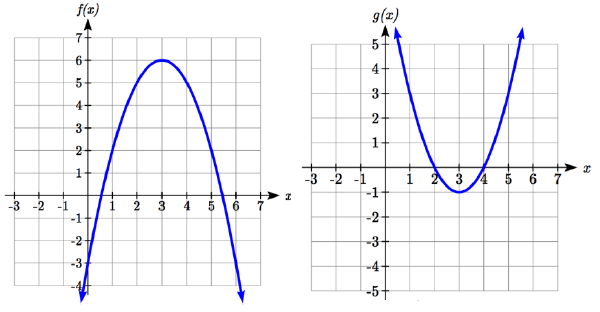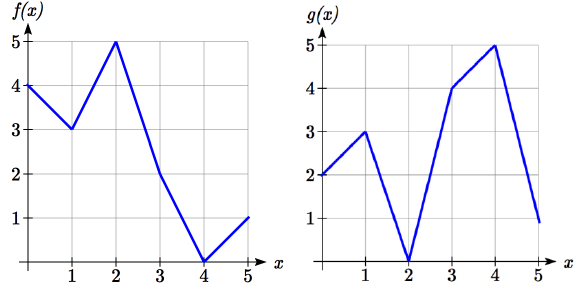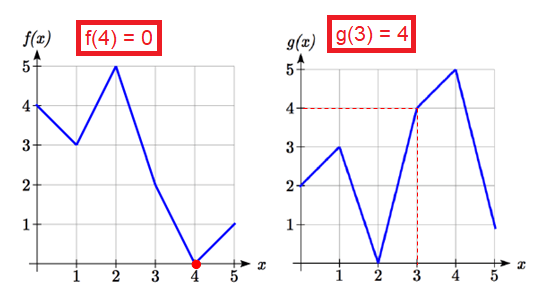COMPOSITION OF FUNCTIONS FROM THE GRAPH
Example 1 :
Using the graphs below, evaluate f (g(1))

Solution :
f (g(1))
The value of g(1) from the graph of g(x) is 3.
So, f (g(1)) = f(3)
Value of f(3) from the graph f(x) is 6.
Then, the value of f (g(1)) is 6.
Example 2 :

Use the graphs to evaluate the expressions below.
(i) f (g(3)) (ii) f (g (1)) (iii) g( f (1)) (iv) g ( f (0))
(v) f( f (5)) (vi) f ( f (4)) (vii) g(g(2)) (viii) g ( g (0))
Solution :
(i) f (g(3))
From the graph of g(x), first we find g(3).
g(3) = 4
f (g(3)) = f(4)
From the graph f(x), we find f(4).
The value of f(4) is 0. So, f(g(3)) = 0.

(ii) f (g (1))
Value of g(1) = 3, then f (g (1)) = f(3)
From the graph of f(x), the value of f(3) is 2.
(iii) g( f (1))
Value of f(1) = 3, then g (f (1)) = g(3)
From the graph of g(x), the value of g(3) is 4.
(iv) g ( f (0))
Value of f(0) = 4, then g (f (0)) = g(4)
From the graph of g(x), the value of g(4) is 5.
(v) f( f (5))
Value of f(5) = 1, then f (f (5)) = f(1)
From the graph of f(x), the value of f(1) is 3.
(vi) f ( f (4))
Value of f(4) = 0, then f (f (4)) = f(0)
From the graph of g(x), the value of f(0) is 4.
(vii) g(g(2))
Value of g(2) = 0, then g (g (2)) = g(0)
From the graph of g(x), the value of g(0) is 2.
(viii) g ( g (0))
Value of g(0) = 2, then g (g (0)) = g(2)
From the graph of g(x), the value of g(2) is 0.
Example 3 :
Use the graphs to evaluate the composition of functions.
(i) (g ∘ f)(1)
(ii) (g ∘ f)(5)
(iii) (f ∘ g)(0)
(iv) (f ∘ g)(2)

Solution :
(i) (g ∘ f)(1) = g[f(1)]
The value of f(1) is -1.
g[f(1)] = g(-1)
The value of g(-1) is 3.
(g ∘ f)(1) = 3
(ii) (g ∘ f)(5) = g[f(5)]
The value of f(5) is 1.
g[f(5)] = g[1]
The value of g(1) is 4.
(g ∘ f)(5) = 4
(iii) (f ∘ g)(0) = f[g(0)]
The value of g(0) is 5.
f[g(0)] = f(5)
The value of f(5) is 1.
(iv) (f ∘ g)(2) = f[g(2)]
The value of g(2) is 2.
f[g(2)] = f(2)
The value of f(2) is -2.
(f ∘ g)(2) = -2
Recent Articles
-
Finding Range of Values Inequality Problems
May 21, 24 08:51 PM
Finding Range of Values Inequality Problems -
Solving Two Step Inequality Word Problems
May 21, 24 08:51 AM
Solving Two Step Inequality Word Problems -
Exponential Function Context and Data Modeling
May 20, 24 10:45 PM
Exponential Function Context and Data Modeling